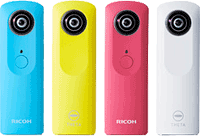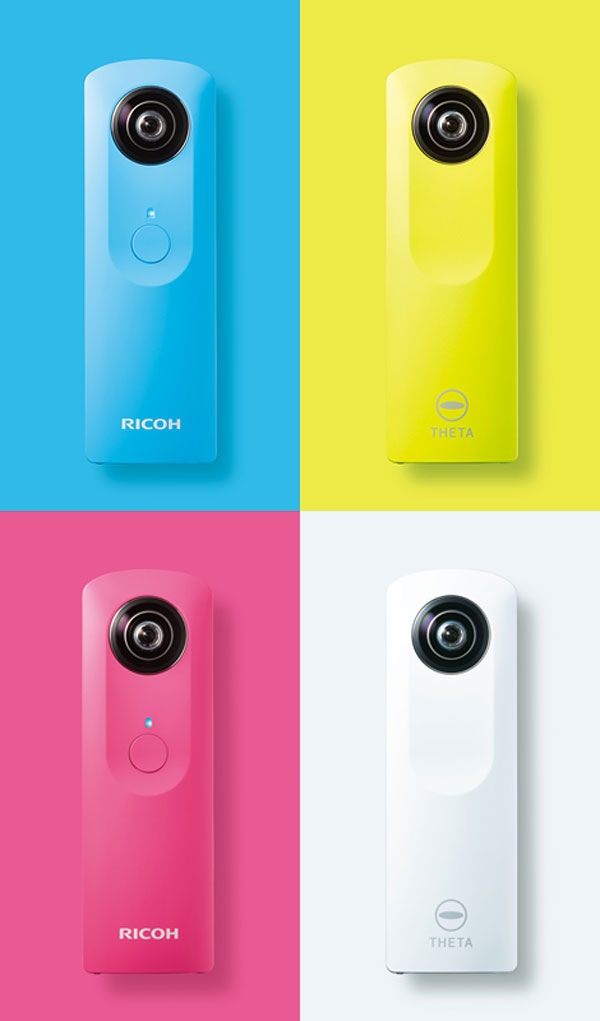Ricoh Theta successor adds 360-degree spherical video; third-party developers courted with new SDK
posted Wednesday, October 29, 2014 at 2:43 PM EDT

Back in early 2013, Ricoh first showed a prototype of one of the most unusual digital cameras we've ever seen, featuring twin fisheye lenses facing in opposite directions. The idea of that camera, which six months later hit retail as the Ricoh Theta, was that it would capture a full 360-degree spherical panorama in a single press of the shutter button, automatically stitching together imagery captured by each lens.
Since both images were captured simultaneously, the Ricoh Theta solved a significant issue for panoramic photography -- that of moving subjects, which can cause ghosting and partial or repeated subjects in multi-shot panoramas. However, that final retail product lacked a key feature of the original concept camera -- and sadly, it was one of its most interesting capabilities. Now, the followup Ricoh Theta M15 arrives, and corrects the oversight in its predecessor.
As well as 360-degree stills, the Ricoh Theta M15 can now shoot full 360-degree spherical panoramic video clips as long as three minutes, as well. Videos are saved using MPEG-4 AVC/H.264 compression with Linear PCM audio. (Whether monaural or stereo, we're not yet certain.) The addition of video capture opens up a whole new world of possibilities for this unusual little device. Imagine, for example, being able to provide a video of a concert that lets viewers choose whether they prefer to watch the band on stage, or spin around to see the crowd's reactions. Or set up by a Ricoh Theta at the race track, and you could capture that unexpected pass for the lead -- even if you happened to be looking in the wrong direction at the crucial moment.

Admittedly, you'd have to start recording within a few minutes of the crucial moment due to the three-minute clip-length limit, and Ricoh has not yet stated the video capture resolution but given the complexity of encoding and storing video from twin lenses in real time, it's perhaps understandable that there's a fairly strict limit. (Note, though, that stitching is not done in-camera for videos: Instead, a post-capture app is used to stitch two separate video feeds to create the final 360-degree video on the desktop.)
As with its predecessor, the Theta M15 can also be controlled via Wi-Fi from a smartphone app, and stores its creations on 4GB of internal memory. Ricoh says this is sufficient for a total of 40 minutes of video clips, hinting at a bitrate of around 13.5Mbps. While photos still have a sensitivity range of ISO 100 to 1600 equivalents and a shutter speed range of 1/8,000 to 1/7.5 seconds, in video mode, the upper limits drop to ISO 400 and 1/15 second, respectively.
The ability to create immersive videos isn't completely unique to the Theta M15, but this is certainly the first such product we've seen from a mainstream manufacturer to offer this ability, and it makes the M15 version a much more interesting product than was its predecessor. After all, with careful stitching and a relatively static scene, you could manage what the original Theta did using your standard camera, but 360-degree video is an entirely different ball game.
Video isn't the only change in the Ricoh Theta M15. The new model is also said to provide approximately double the Wi-Fi transfer speeds, and it is now available in pink, yellow and blue-bodied variants as well as the original white body. Priced at US$300 -- a full US$100 less expensive than its predecessor -- the Ricoh Theta M15 ships in the US market from November 2014.
And developers interested in creating apps for the device can now register to get access to Ricoh's SDK and API, allowing them to create apps for Android and iOS devices that will leverage the unique capabilities of the Theta and Theta M15 cameras in new ways. Remote shutter release, remote video capture (for the M15 only), and remote settings control will all be possible, as well as control of image files on the camera itself. The SDK and API will be available from November 14th; more details can be found here.